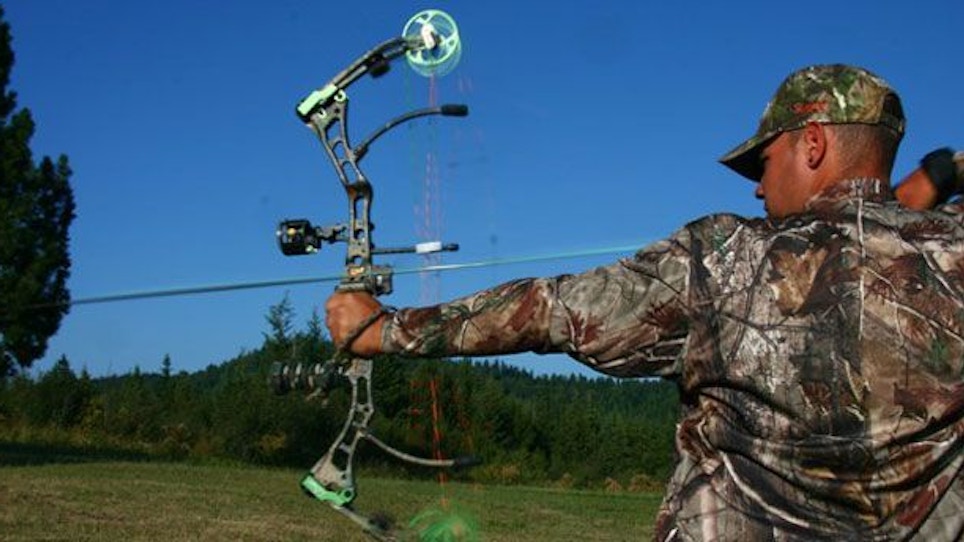Using bowsights has become standard in bowhunting circles, save the traditional recurve or longbow man. Bowsights, combined with a rear peep or peep-eliminating system, offer repeatable accuracy that those who do not use sights simply cannot enjoy. What’s sacrificed in fluid instinctual style is more than compensated for by allowing you to shoot farther with confidence and produce more repeatable results with less practice. Yet there’s more to a seamless shot cycle than jerking your pins into a bull’s-eye and letting ’er rip. The “Triple-A” aiming system (Align, Acquire, Aim) helps develop a blueprint for maintaining top-notch accuracy, especially under pressure. Most importantly, it keeps the windows shuttered against debilitating target-panic.
 Align
Align
After reaching full draw, a couple things must happen before continuing any shot. Aligning all the parts of your shooting system is the start. Centering a single pin with a smaller-diameter peep sight is old-school, though it is still viable for target shooters who require fractions-of-an-inch accuracy in big-money 3-D tournaments. In bowhunting you’re interested only in one-arrow groups inside a 9-inch bull’s-eye—the circumference of the heart/lung area of an average whitetail.
Recently savvy bowhunters have found circling a round pin guard inside their peep allows a larger-diameter peep (1/4-inch or slightly bigger) and increased low-light efficiency without sacrificing accuracy. The human eye naturally tends to center objects inside circles, making the system highly intuitive.
At this point in the shot cycle it’s acceptable to close one eye (if needed) to eliminate confusion, especially for cross-eye dominant shooters, shooting right-handed with a left-dominant eye, for example.
 Acquire
Acquire
Only after you’ve aligned front and rear sights (pins and/or pin head plus peep and/or peep eliminator) should you acquire the target. Now, I didn’t say aim, I said acquire. This distinction often confuses people. Acquiring the target with and aligned pin/peep should not be confused with actual aiming, as we shall see in a moment. This means only getting the proper pin on the general target area you wish to address, in the vicinity of a 3-D target’s 8-ring, or on a whitetail deer’s ribs—even an entire cow patty you’re about to send a judo point through.
At this point both eyes should be opened. Two eyes always gather more light than one, and the fact is, judging distance is greatly handicapped by closing an eye. Squinting also requires conscious thought and sometimes tension. Leaving both eyes open results in a more relaxed shot. If confusing double images appear, squint momentarily only to regain alignment, but execute the final shot with both eyes.
 Aim
Aim
This is where everything comes together. This is really several steps within a step, though all meld into a single seamless sequence. Your sights are aligned perfectly, aiming point is on target, both eyes are open. Now you begin actual aiming. First—Pick A Spot! Find the smallest point you can possibly discern on a 3-D target, live animal, even that cow patty. Depending on eyesight or range, this could be a single arrow hole in a 3-D target or a shadow falling on the proper score ring. It could be a single mussed hair on a buck’s side or a depression between ribs. It doesn’t matter. Pick a spot and burn a hole through it with every ounce of your existence.
Now, while focusing on only that spot, looking through the proper pin for the range at hand (don’t focus on the pin itself), allow the pin to float, find its own center. Don’t attempt to force the pin on target; just allow it to float, feeling the shot into the center. Aiming too finely—trying to be perfect—results in tense spasms and twitches that ruin the shot. During the entire shot, engage strong back muscles to hold the shot steady, allowing arms, especially the bow grip, to remain relaxed. And just allow the shot, the release, to happen. Following the shot explosion, continue burning a hole through your spot until impact.
Of course everything discussed above, depending on how often you invest in quality practice (never shortcut or become sloppy with these steps), comes off in seconds rather than the long minutes required to relate it on paper. With enough conscious, mechanical repetition during quality practice sessions the approach eventually (after only a month, say) allows a calm, auto-pilot approach to shooting, even under the most stressful encounters with trophy game.






